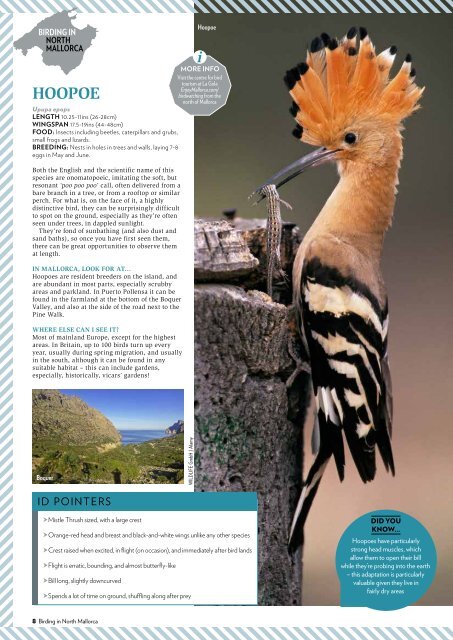You also want an ePaper? Increase the reach of your titles
YUMPU automatically turns print PDFs into web optimized ePapers that Google loves.
BIRDING IN<br />
<strong>NORTH</strong><br />
<strong>MALLORCA</strong><br />
Hoopoe<br />
Puig Nassi i Son Poc<br />
MORE INFO<br />
Visit the centre for bird<br />
tourism at La Gola<br />
EnjoyMallorca.com/<br />
HOOPOE<br />
birdwatching from the<br />
north of Mallorca<br />
Upupa epops<br />
LENGTH 10.25-11ins (26-28cm)<br />
WINGSPAN 17.5-19ins (44-48cm)<br />
FOOD: Insects including beetles, caterpillars and grubs,<br />
small frogs and lizards.<br />
BREEDING: Nests in holes in trees and walls, laying 7-8<br />
eggs in May and June.<br />
Both the English and the scientific name of this<br />
species are onomatopoeic, imitating the soft, but<br />
resonant ‘poo poo poo’ call, often delivered from a<br />
bare branch in a tree, or from a rooftop or similar<br />
perch. For what is, on the face of it, a highly<br />
distinctive bird, they can be surprisingly difficult<br />
to spot on the ground, especially as they’re often<br />
seen under trees, in dappled sunlight.<br />
They’re fond of sunbathing (and also dust and<br />
sand baths), so once you have first seen them,<br />
there can be great opportunities to observe them<br />
at length.<br />
IN <strong>MALLORCA</strong>, LOOK FOR AT…<br />
Hoopoes are resident breeders on the island, and<br />
are abundant in most parts, especially scrubby<br />
areas and parkland. In Puerto Pollensa it can be<br />
found in the farmland at the bottom of the Boquer<br />
Valley, and also at the side of the road next to the<br />
Pine Walk.<br />
WHERE ELSE CAN I SEE IT?<br />
Most of mainland Europe, except for the highest<br />
areas. In Britain, up to 100 birds turn up every<br />
year, usually during spring migration, and usually<br />
in the south, although it can be found in any<br />
suitable habitat – this can include gardens,<br />
especially, historically, vicars’ gardens!<br />
BLACK VULTURE<br />
Aegypius monachus<br />
LENGTH 39-43ins (100-110cm)<br />
WINGSPAN up to 9ft (2.8m)<br />
FOOD: Carrion of all sorts – at carcasses, they can even<br />
dominate Griffon Vultures and take the choice parts.<br />
BREEDING: Makes a bulky nest of sticks in a tree and<br />
(very rarely) on cliffs. A single egg is laid.<br />
Unlike most Old World vultures, which breed in colonies, Black Vultures<br />
do so only in looser groups, and are also less likely to be sociable away<br />
from the nest. Although in some areas they occur alongside the Griffon<br />
Vulture, with which they can be confused at distance, they are far less of<br />
a bird of the mountains than the commoner species.<br />
They are the dominant raptors throughout their range, even bullying<br />
other large vultures and eagles at kills, and on rare occasions may even<br />
take live prey.<br />
IN <strong>MALLORCA</strong>, LOOK FOR AT…<br />
Mallorca’s most important and sought-after breeding bird is only found in<br />
the Serra de Tramuntana. Nearly extinct on the island in the early 1980s, a<br />
conservation project was started in 1983, with the help of the regional<br />
government of the Balearic Islands. The first breeding success was in<br />
1986, and there are now more than 130 birds, after a record breeding year<br />
in 2014. They nest in the north of the Tramuntana Mountains, but also<br />
feed in places around the Boquer Valley. The best sites to look for them<br />
are at Mortitx, the monastery at Lluc (where there’s a visitor centre for the<br />
Tramuntana), the Cuber Reservoir, and Castell Del Rei, on the Ternelles<br />
estate, near Pollença.<br />
WHERE ELSE CAN I SEE IT?<br />
Small numbers in the Balkans and Asia<br />
Minor, and also found in the<br />
Extremadura region of mainland<br />
Spain, but otherwise you would be<br />
best to travel to central Asia.<br />
ID POINTERS<br />
Always appears dark – even the wings show only<br />
very subtle contrasts<br />
Largest of its family in Europe, although some<br />
overlap with larger individual Griffon Vultures<br />
Found mainly in hilly, wooded or partiallywooded<br />
areas<br />
Soars in wide circles on flat wings<br />
(Griffon Vultures soar on raised wings)<br />
Perches more horizontally and less upright than<br />
Griffon Vultures<br />
Almost silent, but display flights include pairs<br />
tumbling with feet interlocked<br />
Black Vulture<br />
Boquer<br />
WILDLIFE GmbH / Alamy<br />
MORE INFO<br />
Learn more at<br />
enjoymallorca.com/<br />
theserrade<br />
tramuntanamountains<br />
ID POINTERS<br />
Mistle Thrush sized, with a large crest<br />
Orange-red head and breast and black-and-white wings unlike any other species<br />
Crest raised when excited, in flight (on occasion), and immediately after bird lands<br />
Flight is erratic, bounding, and almost butterfly-like<br />
Bill long, slightly downcurved<br />
Spends a lot of time on ground, shuffling along after prey<br />
DID YOU<br />
KNOW…<br />
Hoopoes have particularly<br />
strong head muscles, which<br />
allow them to open their bill<br />
while they’re probing into the earth<br />
– this adaptation is particularly<br />
valuable given they live in<br />
fairly dry areas<br />
DID YOU<br />
KNOW…<br />
Black Vultures are also known<br />
as Monk Vultures (a reference<br />
to their bald head and ruff of<br />
neck feathers), or Cinereous<br />
Vultures, often to avoid confusion<br />
with the North American<br />
Black Vulture<br />
PAUL STERRY/Nature Photographers<br />
8 Birding in North Mallorca<br />
birdwatching.co.uk 9


